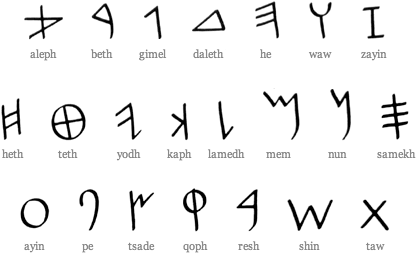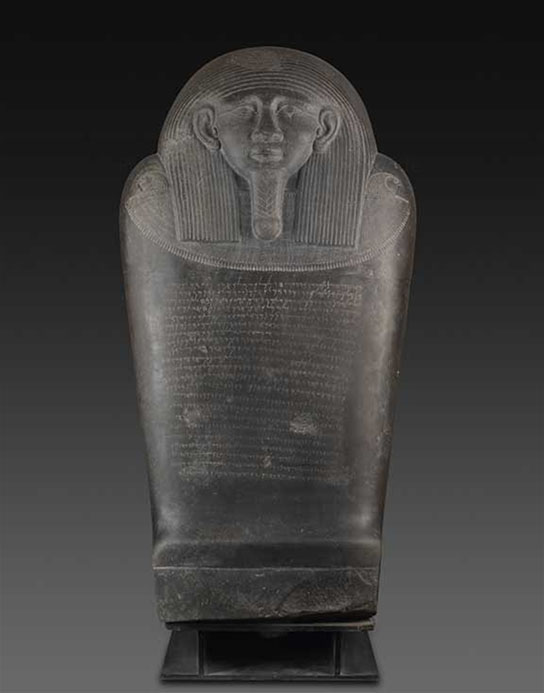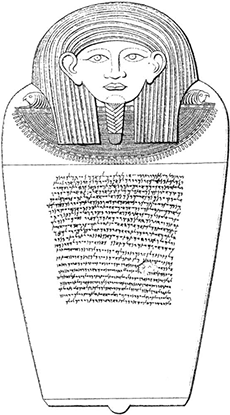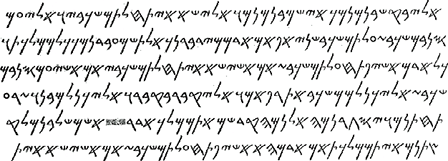12
Sarcophagus of Eshmunazar II
Phoenician
This carved basalt anthropoid sarcophagus, discovered in Sidon in 1855 during the Pérétié excavations, was carved for Eshmunazar II, the king of Sidon. and dates to about the beginning of the fifth century BC. The striking design, where only the head is carved in relief, is clearly influenced by Egyptian design but has a 22-line Phoenician inscription carved on the shroud. The epitaph begins with an appeal by a king who died before his time and continues with a curse on anyone who would disturb the king's rest "...and the sacred gods shall inflict extirpation on them,"1 and, finally, a genealogy of the royal family:
Exactly who the Phoenicians2 were is not really known; they may have been the descendants of the Canaanites, or of the Cushites, or the Philistines, or whatever, but by ca.1200 BC they had formed major city-states in Tyre, Byblios and Sidon, and began extensive maritime trade, first with Greece, their neighbor to the West and later throughout the Mediterranean. Herodotus, in his Histories, describes the Phoenicians as “freighting their vessels with the wares of Egypt and Assyria…”, but perhaps their most famous export was Tyrian Purple, a red-purple dye, highly prized by the Greeks, and later by the Romans.3 At the height of their empire they had established sea routes and colonies as far west as Morocco and Spain, and land routes as far East as the Indus River Valley.
The Phoenicians adopted the Proto-Sinatic or Canaanite script sometime around 1500 BC, possibly in Byblios, and modified it for their own language, creating a phonetic “alphabet” (technically still an abjad) of 22 letters, which was written right to left.4 Eventually, around 300 BC, Phoenician was replaced by Aramaic, but Punic, a cursive Phoenician from Carthage, survived until about 300 AD.

The simple phonetic nature of Phoenician, as well as their extensive trade routes, resulted in the script being adopted by many civilizations. In the West it became Greek → Etruscan → Latin, or Greek → Cyrillic → Glagolitic. In the East it became Aramaic → Hebrew, or Aramaic → Nabataen → Arabic, or Aramaic → Brahmi → Devanagari, etc, etc. The point is that nearly every written script in use today, aside from the Chinese ones, are directly descended from Phoenician. It was the Mother of all alphabets.
1. “... O thou (reader) remember this: May no royal race and no man open my funeral couch, and may they not seek after treasures, for no one has hidden treasures here, nor move the coffin out of my funeral couch, nor molest me in this funeral bed, by putting another tomb over it. Whatever a man may tell thee, do not listen to him: For the punishment shall be: Every royal race and every man, who shall open the covering or this couch, or who shall carry away the coffin where I repose, or who shall molest me in this couch: they shall have no funeral couch with the Rephaïm, nor shall be buried in graves, nor shall there be any son or offspring to succeed to them, and the sacred gods shall inflict extirpation on them...”
2. The Phoenicians called themselves Canaan or Kana’an. It was the Greeks who called them the Phoenicians (Phoiníkē, Φοινίκη, purple) after their purple dye, see: note 3. Phonetics, phonics, phonology, etc, all come from the word Phoenician, and Bible comes from the Greek biblion (Βίβλος, a paper, scroll or book) a diminutive of Byblios, after the Phoenician city-state.
3. Tyrian purple, also known as royal purple or imperial purple, is a dye from hypobranchial gland excretions of the gastropod Murex brandaris. The main component being 6,6′-dibromoindigo [CAS 17670-06-3]. The Phoenicians developed Tyrian purple facilities in Tyre (hence the name), and later, in Mogador, Morocco. Little is known about the exact production methods, but apparently, the snails were gathered in large vats and left to decompose, leaving a hideous stench, a fact mentioned by ancient authors.
Later the plant dye indigotin (2,2’-Bis(2,3-dihydro-3-oxoindolyliden)) [CAS 482-89-3], from the genus Indigofera became the primary source for indigo. In 1897 Adolph von Baeyer developed the first synthetic process for indigo (for which he was awarded the Nobel Prize in Chemistry in 1905). Today, virtually all indigo is synthetic and the large majority of that is used to dye cotton for denim jeans. It should be noted, however, that Tyrian purple has never been synthesized in commercial quantities and is still considered superior to the plant-based or synthetic dyes.
4. In fact, Phoenician is a continuation of Proto-Sinaitic or Old Canaanite. Historians consider Old Canaanite to become, by definition, Phoenician in 1050 BC. The date roughly corresponds to the oldest known Phoenician inscriptions, such as the Abrihim sarcophagus inscription.
12 Jan 2009, updated 27 Dec 2011 ‧ Typographia Historia


